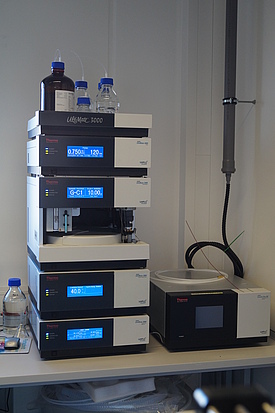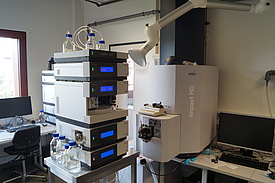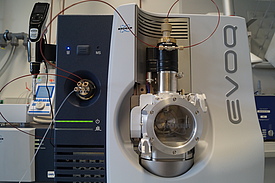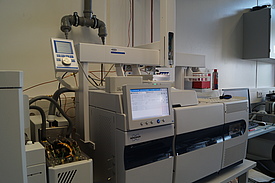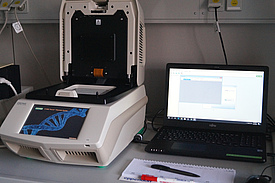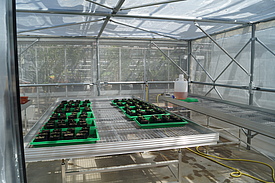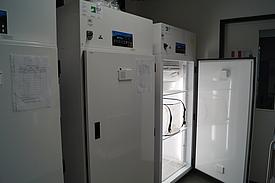Facilities & Platforms
High Pressure Liquid Chromatography (HPLC) platform
At MIE we routinely run an UltiMate™ 3000 HPLC system (Thermo Scientific) for the targeted analyses of plant metabolites, especially glucosinolates. The system consists of a binary pump with degasser unit, a temperature controlled automatic injector unit fitting 120 1-ml sample vials, and a temperature controlled column compartment. In addition to a photodiode array (PDA) detector (UV-VIS range, 200-600 nm) the system is also equipped with a Corona Veo RS Charged Aerosol detector (CAD, Thermo Scientific). Peak detection and identification is automatized using the Chromeleon Chromatography Data Systems software.
- We routinely extract and analyse glucosinolates (GSL) from various plant materials. Our extraction protocol is based on the methods published by the European Commission (EC 1990) and publications of specialists in the field (e.g. Brown et al. 2003). In brief, the GSL are extracted from freeze-dried and ground plant materials using 70% methanol. The extracts are boiled to deactivate the enzyme myrosinase, brought on a DEAE Sephadex column for purification, and treated overnight with sulfatase. The desulfated GSL are eluted and analysed on our HPLC-PDA system. Our analyses are validated using twelve reference glucosinolates (Phytoplan, Heidelberg, Germany) as well as LC-qToF-MS analyses in our own lab.
If you are interested in receiving our extraction protocol or to visit our lab for doing your own glucosinolate analyses, please contact Nicole van Dam.
Responsible person: Prof. Dr. Nicole van Dam, Rebekka Sontowski, Axel Touw.
Untargeted metabolite screening and identification (UPLC-qToF)
Understanding the interactions in above-belowground interactions depends on a deeper knowledge about the chemistry of the molecules involved. The Bruker qToF allows us to detect low abundant molecules and gives us the possibility to identify them via MS-MS experiments. The acquired data will be further processed by chemometric tools to discover differences between treatments or regulatory patterns in different plant species.
The Bruker Impact gives us high mass resolution while at the same time allows us to perform MS-MS experiments. This allows us to get accurate mass information on plant metabolites and clues for their structural elucidation.
Features are:
- ESI and APCI
- Fast and robust chromatography
- MS-MS Experiments
Responsible person: Dr. Andreas Schedl, Dr Stefanie Döll & Dr. Alexander Weinhold
Targeted analysis and quantification (LC-QqQ)
Apart from the chemical structure, the function of many metabolites is dependent on their abundance. For instance, the concentration of phytohormones like jasmonic acid or salicylic acid is important for the elicitation of plant defense responses. The concentration of many defensive metabolites like glucosinolates is determining their defensive potential against herbivores.
The Bruker EVOQ Triple-Quad mass spectrometer allows us to quantify phytohormones and defensive metabolites in a robust manner. It gives us the possibility to detect even trace levels but also comes with a wide linear range for quantification.
Features are:
- ESI and APCI
- Single Ion Monitoring
- Multi Reaction Monitoring
Responsible person: Dr. Andreas Schedl.
Untargeted Screening and Quantification of Volatiles (GC-QqQ)
Volatile organic compounds (VOC) play a key role in above- and belowground interactions. The Bruker SCION Triple quadrupole mass spectrometer gives us the possibility to measure VOCs from to trace level to high concentrations. Connected to Markes thermodesorption unit it allows us the trap volatiles in vivo from leafs or soil. The VOCs can be quantified and the mass spectrometer allows us to elucidate their chemical structure.
Features are:
- Chemical or electron impact ionization
- Single Ion Monitoring or Multi Reaction Monitoring
- Direct Thermodesorption with recollection
- SPME
- Headspace
Responsible person: Dr. Alexander Weinhold
Molecular Lab
Research activities in the Molecular Lab are concentrated on unraveling the molecular mechanisms governing interactions between plants and their biotic and abiotic environment. This includes the isolation of nucleic acids and proteins, their quantification, characterization and gene expression of different plant species.
Our facilities include a Real-time PCR system (BioRad CFX384/96 Touch) for gene expression analyses, a gel doc system (QUANTUM Viber Lourmat), a sterile workbench (Safe 2020) and a PCR Cabinet.
Responsible person: Rebekka Sontowski.
Greenhouse
Cultivation of plants and insects, as well as experiments can be conducted in the greenhouse of the Botanical Garden Leipzig. The famous botanical garden is just a 10 minutes walk away from the iDiv building. It is possible to use two compartments of the greenhouse with a size of around 96m² and 25m². Greenhouse conditions like temperature, humidity, light intensity and day/night rhythm can be controlled depend on the season. Additionally one of the compartments is equipped with a net to control aphids and other insects.
Percival chambers
Five incubators from Percival can be used for bacterial culturing, insect rearing and plant seedling within the iDiv building. Here, the environmental conditions like temperature, humidity, light intensity and a day/night rhythm can be controlled. Moreover, it is possible to use the two climate chambers from the CLF PlantMaster series within the iDiv building. The PlantMaster Series offers a control of temperature ranges, light intensities and humidity levels. One of the shared chambers is equipped with an automatic watering system.
Responsible person: Dr. Katharina Grosser
